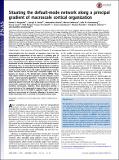Situating the default-mode network along a principal gradient of macroscale cortical organization
Author(s)
Margulies, Daniel S.; Goulas, Alexandros; Falkiewicz, Marcel; Huntenburg, Julia M.; Bezgin, Gleb; Eickhoff, Simon B.; Castellanos, F. Xavier; Petrides, Michael; Jefferies, Elizabeth; Smallwood, Jonathan; Ghosh, Satrajit S; Langs, Georg; ... Show more Show less
DownloadMargulies-2016-Situating the default-mode netw.pdf (1.114Mb)
PUBLISHER_POLICY
Publisher Policy
Article is made available in accordance with the publisher's policy and may be subject to US copyright law. Please refer to the publisher's site for terms of use.
Terms of use
Metadata
Show full item recordAbstract
Understanding how the structure of cognition arises from the topographical organization of the cortex is a primary goal in neuroscience. Previous work has described local functional gradients extending from perceptual and motor regions to cortical areas representing more abstract functions, but an overarching framework for the association between structure and function is still lacking. Here, we show that the principal gradient revealed by the decomposition of connectivity data in humans and the macaque monkey is anchored by, at one end, regions serving primary sensory/motor functions and at the other end, transmodal regions that, in humans, are known as the default-mode network (DMN). These DMN regions exhibit the greatest geodesic distance along the cortical surface—and are precisely equidistant—from primary sensory/motor morphological landmarks. The principal gradient also provides an organizing spatial framework for multiple large-scale networks and characterizes a spectrum from unimodal to heteromodal activity in a functional metaanalysis. Together, these observations provide a characterization of the topographical organization of cortex and indicate that the role of the DMN in cognition might arise from its position at one extreme of a hierarchy, allowing it to process transmodal information that is unrelated to immediate sensory input.
Date issued
2016-10Department
Massachusetts Institute of Technology. Computer Science and Artificial Intelligence Laboratory; McGovern Institute for Brain Research at MITJournal
Proceedings of the National Academy of Sciences
Publisher
National Academy of Sciences (U.S.)
Citation
Margulies, Daniel S.; Ghosh, Satrajit S.; Goulas, Alexandros; Falkiewicz, Marcel; Huntenburg, Julia M.; Langs, Georg; Bezgin, Gleb et al. “Situating the Default-Mode Network Along a Principal Gradient of Macroscale Cortical Organization.” Proceedings of the National Academy of Sciences 113, no. 44 (October 2016): 12574–12579. © 2016 National Academy of Sciences
Version: Final published version
ISSN
0027-8424
1091-6490